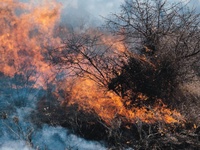
The objectives of the model are:
- to display an equilibrium between fire, vegetation & climate
- to simulate human- & lightning caused wildfires in (potential) natural vegetation
- to develop a process-based fire model which includes:
- Climatic fire danger: Risk for fire ignition
- Ignitions (Lightning & human-caused)
- Surface fire spread in homogenous fuel bed
- Fire behaviour & Post-fire mortality
- C emissions resulting from surface fire and crown scorch
We use the LPJmL model to input:
- aboveground litter which is subdivided into fuel-size classes annually such as dead grass, fine twigs, proportion of sapwood and heartwood to represent twigs, branches and tree boles
- other input variables from LPJmL: FPC tree vs. grass Tree height
- as PFT parameter we use fire spread features such as moisture of extinction and fuel bulk density. Fire behaviour and post-fire mortality is depicted by using: crown length, bark thickness, crown damage, emission factors
The output from SPITFIRE to LPJmL:
- area burnt
- biomass burnt
- remaining dead aboveground biomass à litter/fuel classes
Resolution: 0.5° x 0.5° grid cell
Daily: fire processes, including updating vegetation carbon pools and number of plant individuals in case of post-fire mortality
Daily/Monthly: calculating fire output variables
Annual: update of vegetation dynamics in LPJmL
Model features: Fire Danger Index, Number of Ignitions, Spread, Effects, fire-related emissions
Model Evaluations: Performance of monthly simulated burnt areas vs. earth observation-based burnt area products
Summarization:
After undergoing model evaluations with MODIS (active fires and seasonality) and AVHRR, MODIS (i.e. area burnt) and extensive model inter-comparisons with GFED emission models, SPITFIRE has reached a stage at which it reproduces a realistic global distribution of fire regimes. It calculates seasonality and inter-annual variability, the spatial distribution has been validated in data-model inter-comparison. The global biomass burning is within range of other estimates.
Publication:
Thonicke, K., Spessa, A., Prentice, I. C., Harrison, S. P., Dong, L., and Carmona-Moreno, C. 2010: The influence of vegetation, fire spread and fire behaviour on biomass burning and trace gas emissions: results from a process-based model, Biogeosciences, 7, 1991-2011, doi:10.5194/bg-7-1991-2010, 2010.





